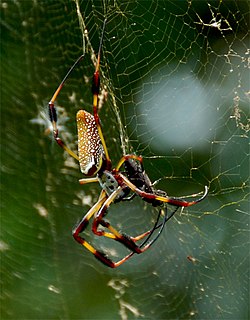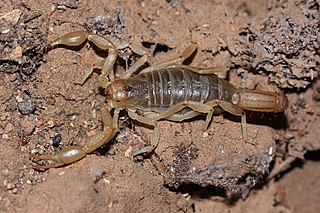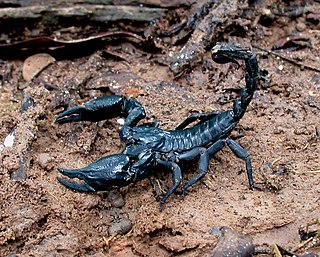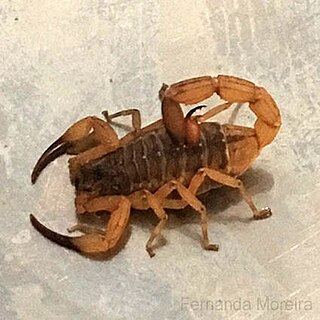
Scorpions are predatory arachnids of the order Scorpiones. They have eight legs, and are easily recognized by a pair of grasping pincers and a narrow, segmented tail, often carried in a characteristic forward curve over the back and always ending with a stinger. The evolutionary history of scorpions goes back 435 million years. They mainly live in deserts but have adapted to a wide range of environmental conditions, and can be found on all continents except Antarctica. There are over 2,500 described species, with 22 extant (living) families recognized to date. Their taxonomy is being revised to account for 21st-century genomic studies.

The subphylum Chelicerata constitutes one of the major subdivisions of the phylum Arthropoda. It contains the sea spiders, horseshoe crabs, and arachnids, as well as a number of extinct lineages, such as the eurypterids and chasmataspidids.

Scorpions are a German rock band formed in 1965 in Hanover by Rudolf Schenker. Since the band's inception, its musical style has ranged from hard rock, heavy metal, glam metal, and soft rock. The lineup from 1978 to 1992 was the most successful incarnation of the group, and included Klaus Meine (vocals), Rudolf Schenker, Matthias Jabs, Francis Buchholz (bass), and Herman Rarebell (drums). The band's only continuous member has been Schenker, although Meine has appeared on all of Scorpions' studio albums, while Jabs has been a consistent member since 1978, and bassist Paweł Mąciwoda and drummer Mikkey Dee have been in the band since 2003 and 2016 respectively.

Arachnology is the scientific study of arachnids, which comprise spiders and related animals such as scorpions, pseudoscorpions, and harvestmen. Those who study spiders and other arachnids are arachnologists. More narrowly, the study of spiders alone is known as araneology.

USS Scorpion (SSN-589) was a Skipjack-class nuclear-powered submarine that served in the United States Navy, and the sixth vessel, and second submarine, of the U.S. Navy to carry that name.

The emperor scorpion, Pandinus imperator, is a species of scorpion native to rainforests and savannas in West Africa. It is one of the largest scorpions in the world and lives for 6–8 years. Its body is black, but like other scorpions it glows pastel green or blue under ultraviolet light. It is a popular species in the pet trade, and is protected by CITES to prevent over-collecting that might impact the species' survival.

Nepidae is a family of exclusively aquatic Heteropteran insects in the order Hemiptera. They are commonly called water scorpions for their superficial resemblance to scorpions, due to their raptorial forelegs and the presence of a long slender process at the posterior end of the abdomen, resembling a tail. There are 14 genera in the family, in two subfamilies, Nepinae and Ranatrinae. Members of the genus Ranatra, the most widespread and species-rich genus, are sometimes called needle bugs or water stick insects as they are slenderer than Nepa.

"Wind of Change" is a song by West German rock band Scorpions, recorded for their eleventh studio album, Crazy World (1990). The power ballad was composed and written by the band's lead singer Klaus Meine and produced by Keith Olsen and the band. The lyrics were composed by Meine following the band's visit to the Soviet Union at the height of perestroika, when the enmity between the communist and capitalist blocs subsided concurrently with the promulgation of large-scale socioeconomic reforms in the Soviet Union.

Naqada III is the last phase of the Naqada culture of ancient Egyptian prehistory, dating from approximately 3200 to 3000 BC. It is the period during which the process of state formation, which began in Naqada II, became highly visible, with named kings heading powerful polities. Naqada III is often referred to as Dynasty 0 or the Protodynastic Period to reflect the presence of kings at the head of influential states, although, in fact, the kings involved would not have been a part of a dynasty. In this period, those kings' names were inscribed in the form of serekhs on a variety of surfaces including pottery and tombs.

"I Stand Alone" is a song by the American rock band Godsmack. It served as a single from the Scorpion King soundtrack on March 5, 2002. It would reappear on Godsmack's third studio album, Faceless, the following year. It won a 2002 Metal Edge Readers' Choice Award for "Song of the Year From a Movie Soundtrack."

Paravaejovis spinigerus, commonly known as the stripe-tailed scorpion or devil scorpion, is a species of scorpion in the family Vaejovidae. It is found in the south-western United States and north-western Mexico.

Skorpiovenator is a genus of abelisaurid theropod dinosaur from the Late Cretaceous Huincul Formation of Argentina. It is one of the most complete and informative abelisaurids yet known, described from a nearly complete and articulated skeleton.

A scorpion sting is an injury caused by the stinger of a scorpion resulting in the medical condition known as scorpionism, which may vary in severity. The anatomical part of the scorpion that delivers the sting is called a "telson". In typical cases, scorpion stings usually result in pain, paresthesia, and variable swelling. In serious cases, scorpion stings may involve the envenomation of humans by toxic scorpions, which may result in extreme pain, seriousness illness, or even death depending on the toxicity of the venom.

Heterometrus, whose members are also known by the collective vernacular name giant forest scorpions, is a genus of scorpions belonging to the family Scorpionidae. It is distributed widely across tropical and subtropical southeastern Asia, including Indonesia, Brunei, Malaysia, Myanmar, Philippines, Singapore, Cambodia, Laos, Thailand, Vietnam, India, and China (Hainan). It is notable for containing some of the largest living species of scorpions.

The San Antonio Scorpions were an American professional soccer team based in San Antonio, Texas. Founded in 2010, the team made its debut in the North American Soccer League in 2012. The Scorpions played at Toyota Field, a soccer specific stadium that was completed in 2013.

Olivierus martensii is a species of scorpion in the family Buthidae. Its common names include Chinese scorpion, Manchurian scorpion, Chinese armor-tail scorpion and Chinese golden scorpion. Despite its common name, this scorpion is not only found in Manchuria or China, but also in Mongolia and Korea. The record from Japan is doubtful. Its preferred habitat is warm, dry areas with little vegetation. O. martensii can grow to about 6 centimetres (2.4 in) long, with females usually slightly larger, and has a life-span of about 4 to 6 years.

Tityus serrulatus, the Brazilian yellow scorpion, is a species of scorpion of the family Buthidae. It is native to Brazil, and its venom is extremely toxic. It is the most dangerous scorpion in South America and is responsible for the most fatal cases.

Vaejovidae is a family of scorpions, comprising 17 genera, found in North America. The species of the genus are found in Mexico and the southern United States, and Paruroctonus boreus is found in Canada and is the the northernmost species of scorpion in the world.

Gondwanascorpio emzantsiensis is an extinct Gondwanan scorpion that lived 360 million years ago in the Devonian. Its fossil remains, clearly showing pincer and sting, were discovered in rocks of the Witteberg Group near Grahamstown in South Africa. At present this scorpion is the oldest known land-dwelling animal from Gondwana, which in Devonian times was separated from Laurasia by a deep ocean. At the time, the fossil site was only 15° from the South Pole, but rather than arctic like tundra, the region was probably wooded, providing ample insect life for food. Previously only two scorpion species were known from the late Devonian – Hubeiscorpio gracilitarsus from China and Petaloscorpio bureaui from Canada. The species was described by Robert Gess of Wits University in the journal African Invertebrates. The specific epithet derives from umZantsi, the isiXhosa word for "south", sometimes used for South Africa.
The 2015 San Antonio Scorpions FC season was the club's fourth season of existence and its fourth and last season in the North American Soccer League, the second division of the American soccer pyramid. Including the San Antonio Thunder soccer franchise of the original NASL, this was the 6th season of professional soccer in San Antonio. The Scorpions entered the 2015 NASL season as the reigning league champions after defeating the Fort Lauderdale Strikers 2-1 in the 2014 Soccer Bowl.



















